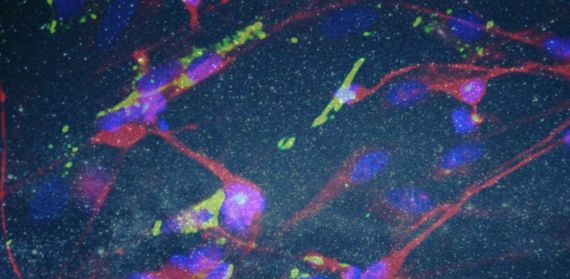Co-authored by Nikolas Rose, Professor of Sociology and Head of the Department of Global Health and Social Medicine at King's College London.

Neurones forming synaptic connection in the brain superimposed to the Milky Way: is our understanding of the mind and the brain equally complex?
The debate on Mind vs. Brain has figured prominently in the recent public press. But the debate is misleading: few dispute that mental life is grounded in the complex circuits of connections between neurons (brain cells) and in their constant interaction with the world outside. The question is really one of how psychiatrists, psychologists and social scientists can work together to link the mental and the neural, rather than fighting about which has priority.
There is probably more in common between the different 'camps' of this debate than may at first appear. For example, most clinicians and scientists, even if coming from different disciplines, agree that mental health problems are best understood as processes that result from a person's difficulties and ailments in the context of the reality of their lives and their personal and social relationships. Similarly, few would dispute the fact that the brain is crucial for all human mental functions, and that psychosocial factors - personal difficulties, life adversities, stress, social relationships - shape both the structure of the brain and the functional circuits that link up the millions of neurons through the synaptic connections between them. There are many pathways between the outside world, individual experiences and feelings, and neuronal processes - that is to say, between society, the body, the mind and the brain - such as via hormones and the immune system, epigenetics, neurogenesis, and the microbiome. Things becomes more controversial, however, when we try to model these dynamic relations and we try to decide where in this complexity our interventions should best be directed if we are concerned to reduce the incidence of mental ill health, or trying to treat those who suffer from mental disorders.
One the one hand, many argue that the bulk of neurobiological research programmes are too reductionist in their thinking that mental disorders can be understood through an analysis of individual brain areas or deficits in specific neural functions. Much research has focussed on the role of individual neurotransmitters (the chemicals that allow brain cells to communicate), and many argue that we need to discard this highly simplified 'neurotransmitter model' of mental health problems that has guided much research and drug development for almost half a century. At least in part, this is because the drugs that have been produced on the basis of this model have been less effective than hoped, and few if any new drugs from this pipeline are in prospect. In contrast, contemporary neurobiology is demonstrating that it is the activities of highly distributed circuits connecting many dispersed areas of brain that are central to understanding the neural correlates of human mental functioning. The creation, modulation and activity of these circuits involve hundreds of different chemicals working in concert, like an orchestra and not like the string quartets favourite by research and pharmaceutical companies so far (for example, serotonin, dopamine, norepinephrine, glutamate).
Yet it remains true that, despite the burgeoning of neurobiological research over the last half century, we still do not know enough about the development and functioning of these neural circuits, and how they give rise to mental states, nor do we know specifically how psychological and social factors map onto brain function at microscopic or macroscopic levels. Thus many argue, with some justification, that we need more reductionist research on the brain and its molecular mechanisms, not less. However, even then, we think this must be research that studies the ways that the brain develops, from conception onwards, in complex and dynamic relations with body and the world outside - for after all, that's what brains were evolved to do, and that's what they achieve over any individual's lifetime. Neurotransmitters may well be a crucial key here, though in a much more complicated way than was previously imagined, because they form the links that create circuits between brain cells. It is quite likely that even what we conceptualise as 'non-drug' interventions, such as a probiotic, fish oil or psychotherapy, eventually converge on modifying the function of the neurotransmitter system. But we still do not know enough about how stress, poverty, isolation, adversity, in childhood or beyond, actually shape and reshape the hugely complex and dynamic internal world of the brain. As has been said before, there are more connections in the human brain than there are stars in our Milky Way galaxy - and those synapses are constantly in flux in timescales ranging from the millisecond to the decade.
Of course, the 'brain' is an organ in the body, but its complexity, and its dynamic nature, make it a very different kind of organ than the heart, the lung or the pancreas. And indeed, we know that to understand the origins of all medical disorders, and to understand what may reduce their incidence, we cannot consider an organ in isolation. A heart attack attacks the heart, of course, and lung cancer is a cancer of the lung, but it would be a rash person to claim that the causes or treatments of either can be focussed on the heart or the lung alone. The brain requires an even more comprehensive approach: recent epidemiological research has shown rates of dementia to be lower than predicted, not as a result of any startling new intervention into the brain, but as a result of a range of long term transformations in lifestyle: reductions in smoking, treatment of high blood pressure, and improvements in general health care.
We all should agree that we need to understand much more about the mechanisms by which 'adversity gets under the skin' and affects some of us and not others. But this can best be done by starting from the human beings as they live their life in a particular cultural, social and physical environment, and not only from the brain isolated in a laboratory model. And this is why it is so crucial that psychiatrists, psychologists and sociologists get together and collaborate in research to overcome the galaxy of unhelpful conceptual barriers.
